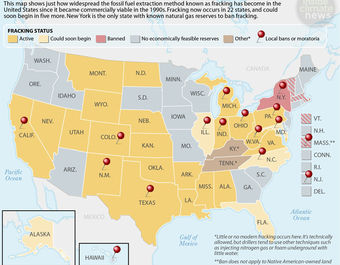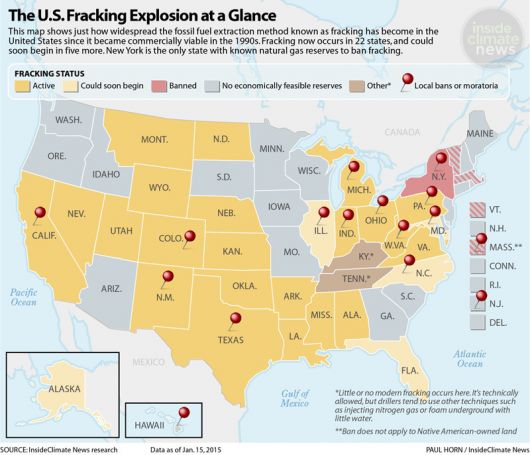
As debate intensifies over oil and gas drilling, most states with frackable reserves are already fracking—or making moves to do so in the near future.
That translates to 22 states, from California to Texas, Michigan to West Virginia, currently employing this high-intensity form of energy extraction, and five others may soon follow. Called high-volume hydraulic fracturing, or fracking, the controversial process became commercially viable in the late 1990s. It generally involves injecting millions of gallons of water, along with sand and chemicals, down a well to extract oil-and-gas reserves that were previously hard to access.
InsideClimate News compiled a comprehensive map of the nation's fracking activity. This state-by-state breakdown will be periodically updated.
 Click
to enlarge
Click
to enlarge
The breakdown
Fracking is used differently in each state, depending on the available fossil fuels. Texas has thousands of wells that tap into deeply buried shale deposits. By contrast, in Indiana, fracking occurs for a small percentage of wells.
Tennessee and Kentucky are outliers. While both states allow high-volume fracking (modern fracking), drillers there tend to use other extraction techniques that can involve injecting nitrogen gas underground.
Illinois is the most recent state to allow modern fracking. The legislature there passed new rules in late 2014, and regulators are waiting for applications. Both North Carolina, which is finalizing rules, and Maryland, which is launching into the rulemaking effort, aren't far behind. Meanwhile, drillers in Alaska are exploring fracking's potential in the state. But there's been little interest in Florida, which technically allows the practice.
New York bucks the trend. It is the only state with sizeable fossil fuel reserves to close its borders to fracking. In December, Gov. Andrew Cuomo banned the practice. His decision cited the public health risks from water and air pollution, and the unknown climate change impacts of extracting natural gas.
Two other states—Massachusetts and Vermont—also prohibit fracking. These drilling restrictions are primarily symbolic because neither region has major resources.
Of the remaining states, some, including Rhode Island, have no known deposits of oil or gas. Georgia and other states have small reserves that could be developed at some point if producers determine it's economically feasible.
Despite many state regulators' embrace of fracking, there's growing local resistance. In Texas, the nation’s top producer of oil and gas, the northeast town of Denton voted to ban any new fracking within city limits in the November elections. And Denton’s not alone. Hundreds of towns, cities, and counties across the country have created similar bans or moratoria in recent years.
COMMENT:
You leave off LOUISIANA. Horizontal fracking STARTED in
northwest LOUISIANA in the Haynesville Shale before anyone even
knew what it was. They collasped an AQUIFER there with gas
drilling. They have poisoned water supplies there for over ten
years now. The people there don't even know what hit them.
Now we are fighting development of the Tuscaloosa Marine Shale
trend in the Southeast corner of the state, just north of New
Orleans. It would be nice to know that the rest of the world
knows that Louisiana's been FRACKED and we are fighting back!
© InsideClimate News
http://insideclimatenews.org/news/20150120/map-fracking-boom-state-state